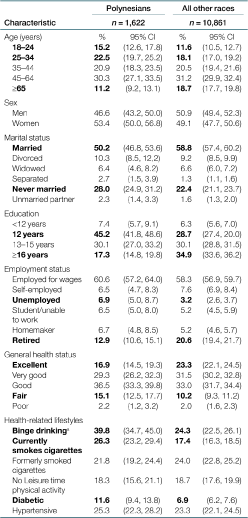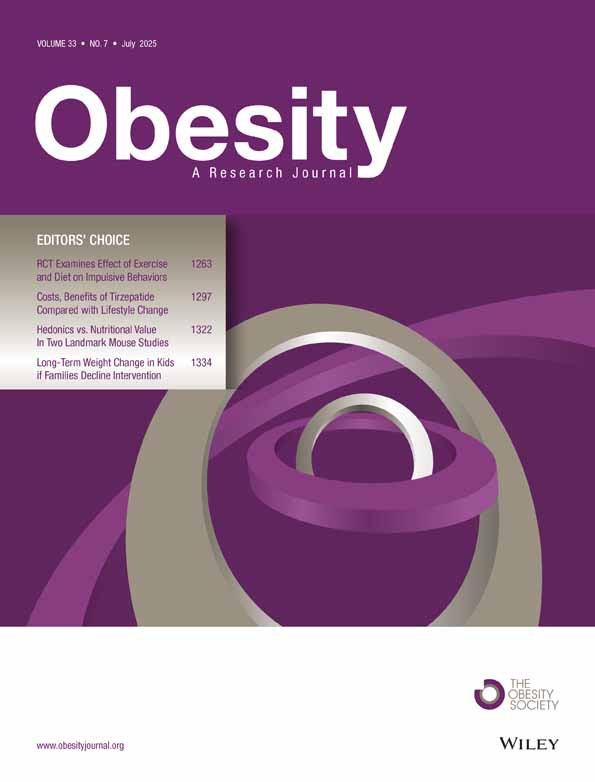Obesity and Self-reported General Health, Hawaii BRFSS: Are Polynesians at Higher Risk?
Abstract
Objective: This study compared the relationship between fair/poor general health status among overweight and obese Polynesians with that among other overweight and obese persons in Hawaii.
Methods and Procedures: Data were pooled from the 1998–2003 Hawaii Behavioral Risk Factor Surveillance System (BRFSS) and logistic regression used to examine the predictors of fair/poor health status.
Results: Polynesians were significantly more likely to be obese than non-Polynesians; overweight Polynesians were more likely than other overweight individuals to report fair/poor health status. After adjusting for confounders, among Polynesians, being obese was no longer associated with fair/poor health. Non-Polynesians who were obese (odds ratio 1.9; 95% confidence interval: 1.4–2.6), older, less educated, smokers, diabetic, hypertensive, and physically inactive were more likely to report fair/poor health.
Discussion: Although Polynesians were significantly more obese than the rest of the Hawaii population, their weight was not independently associated with their odds for fair/poor health as it was with non-Polynesians. The difference may be that, for Polynesians, hypertension and diabetes overrode the effect of obesity on general health status or this group maintains different cultural perceptions of body size. Regardless, these findings show a major health risk among Polynesians and suggest the need for culturally specific health interventions.
The proportion of the US population that is overweight is increasing notably, although more so in certain groups. Being overweight has been directly linked to the risk for type 2 diabetes mellitus, cardiovascular disease, and hypertension (1,2).
Research has shown obesity is independently associated with poorer health-related quality of life, a self-reported measure of physical and mental well-being (3,4). Self-reported general health has also been strongly associated with the number of physically unhealthy days, recent activity limitations (5), with short-term risk for death (6,7), hospitalization (6,8), disabilities (9), and weakly associated with number of mentally unhealthy days (10). Self-reported general health status is the sole Health People 2010 indicator to measure the quality of life and years of healthy life (11).
Polynesians are people with origins in the Pacific Islands, including Hawaii, Samoa, Tonga, and Fiji. Due to ancestral migration of Polynesians through the islands of the Pacific, these islander groups share similar diets and aspects of culture and language. Moreover, these islanders share the experience of Western colonization, suppression of indigenous culture, and societal marginalization. Obesity and obesity-related conditions like type 2 diabetes have been well documented among Polynesians in Hawaii (12,13). Native Hawaiians and Samoans have a significantly higher prevalence of obesity than the persons of other races in Hawaii (14). Moreover, Native Hawaiians have been shown to have the highest early mortality rate in Hawaii, which may in part be associated with obesity and obesity-related health problems (15). To our knowledge, no research has explored the relationship between obesity and low health-related quality of life among Polynesians or how this relationship compares with that among non-Polynesians.
Our objectives were to determine the prevalence of overweight and obesity among Polynesians and non-Polynesians, to compare the prevalence of self-reported fair/poor health among overweight and obese Polynesians with that among overweight and obese non-Polynesians in Hawaii, and to assess the association between overweight/obesity and self-reported health status.
Methods and procedures
The Behavioral Risk Factor Surveillance System (BRFSS) is a state-based system of telephone surveys conducted by state health departments. All states, the District of Columbia, Puerto Rico, Guam, and the Virgin Islands participate. BRFSS uses a multistage cluster design based on random-digit dialing to select a representative sample from each state's non-institutionalized civilian residents aged ≥18 years. Details of the BRFSS have been described elsewhere (14,16). In Hawaii, BRFSS collects detailed racial data, including a breakdown of the specific Asian and Polynesian subgroups. For this study we used BRFSS data from 1998–2003 (N = 24,731), aggregated in order to yield a sufficient number of Polynesians (n = 3,454) for this analysis. Polynesians were defined as the respondents who indicated that they were Native Hawaiian/Part-Hawaiian, Samoan, Tongan, or Fijian. Other racial categories included non-Hispanic whites, non-Hispanic blacks, Hispanics, Asians, and Others, (n = 21,277). Due to the limited sample size of non-Hispanic blacks and Hispanics, and the difficulty in classifying the Others into common racial/cultural backgrounds, we collapsed these groups with non-Hispanic whites and Asians and classified members of all other racial groups as “non-Polynesians.” Preliminary analyses examined six levels of race: non-Hispanic white, non-Hispanic black, Hispanic, Asian, Polynesian, and other; while final analyses focused on Polynesians compared to non-Polynesians.
We calculated respondents' BMI using their self-reported weight and height (kg/m2) and defined a BMI of 18.5–24.9 as normal, a BMI of 25.0–29.9 as overweight, and a BMI of 30.0 or greater as obese. We excluded respondents with a BMI < 18.5 (defined as underweight) since they may have serious underlying health problems, and there were insufficient numbers of Polynesians with a BMI < 18.5 to conduct such analyses. We used general health status as the measure of health-related quality of life to evaluate respondents' health-related well-being. We considered responses of “fair” or “poor” to be indicative of less than optimal health. We used SAS v8 and SUDAAN 9 to adjust for the complex sample design and considered the differences between prevalence estimates to be significant if their 95% confidence intervals did not overlap.
We used other variables collected through the BRFSS to control for potential confounders, including participants' diabetes status, hypertension status, and physical activity status. However, because hypertension data were available only for 1999, 2001, and 2003, only the data from these years could be examined in logistic regression (N = 12,483).
We used logistic regression to analyze the association between reporting fair/poor health and overweight/obesity among Polynesians and non-Polynesians in Hawaii for 1999, 2001, 2003. The model included basic demographic characteristics (age, gender, race/ethnicity, education level) and potential effect modifier, smoking status. We used t-tests (α = 0.05) and 95% confidence intervals to determine statistical significance. We added potential confounding variables to each of the models, including diabetes, physical activity, and hypertension status. Backward selection was used to model the outcome of fair/poor general health.
Results
Aggregated Hawaii BRFSS data for the years 1999, 2001, and 2003 showed that Polynesians (n = 1,622) were significantly younger and were more likely to be unmarried, to have a low education level, to be unemployed or unable to work, to have fair/poor health, to binge drink alcohol, to be current smokers and had diabetes 11.6% vs. 6.9% (95% confidence interval: 9.4–13.8; 6.2–7.6) than non-Polynesians (Table 1).
 |
Obesity was also significantly more prevalent among Polynesians than among non-Polynesians (35.3% vs. 13.3% for 1999, 2001, and 2003). Given the preliminary bivariate analysis results, it would appear that non-Hispanic blacks have a closer prevalence of obesity to Polynesians than other races (26.6% vs. 35.6% for 1999, 2001, 2003); however, Polynesians still have a significantly higher prevalence of obesity than all other races. Overweight/obese Polynesians were significantly more likely to report having fair/poor general health than were overweight/obese non-Polynesians; 16.3% vs. 10.6% overweight/obese (Table 2). When looking across other race categories, overweight Polynesians continued to report the highest prevalence of fair/poor general health, which was significantly greater than overweight non-Hispanic whites and Asians, but similar to the prevalence of overweight Others.
 |
BRFSS data for 1999, 2001, and 2003 showed that among Polynesians, respondents who were obese (odds ratio 2.47, 95% confidence interval: 1.44–4.25), older, and less educated had elevated odds of reporting fair/poor health. After adjusting for confounders, we found that the Polynesians who were less educated, diabetic, hypertensive, or physically inactive were significantly more likely to report fair/poor health, and that obesity was no longer statistically significant in elevating one's odds of reporting fair/poor health (Table 3). Due to the very small sample size of non-Hispanic blacks, Hispanics, and Others, when attempting to conduct further race-specific multivariate analyses, we were unable to obtain results, thus we focused on the collapsed category: non-Polynesians.
 |
After adjusting for confounders, we found that the non-Polynesians who were obese (odds ratio 1.9; 95% confidence interval: 1.4–2.6), older (age >65), less educated, a current/former smoker, diabetic, hypertensive, or physically inactive were significantly more likely to report fair/poor health (Table 3).
Discussion
We found that Polynesians are significantly more likely to be obese than all other Hawaii residents, and are also significantly more likely to report having fair/poor general health than non-Polynesians. However, we found that obesity was independently associated with less than optimal general health among non-Polynesians, but not among Polynesians. It is possible that this lack of association among Polynesians was due to chance. The independent association of obesity and fair/poor general health seen in non-Polynesians may be due in part to social stigmatization and discrimination against obese persons, which has been shown to harm mental well-being (16). It may be that Polynesians do not associate obesity with the psychosocial stigma that contributes to poor general health. Historical cultural perceptions of larger bodies as more desirable may influence the otherwise negative mental health aspects excess weight and obesity confers in Western regions (17). However, given the strong Western influence on the entire population of Hawaii, it is less likely that this different perception of desirable body image removed all effects of obesity on general health (17). This observed lack of association occurred because hypertension and diabetes largely mediated the effect of obesity in predicting fair/poor health in Polynesians, unlike non-Polynesians with whom obesity remained a significant independent risk factor for fair/poor general health.
Our findings of elevated obesity and diabetes among Polynesians may explain their significantly shorter life spans in comparison to other races in Hawaii (18). It is important, therefore, that specific interventions be used to target Polynesians to prevent their suffering disproportionate rates of morbidity and premature death (19). Since obesity predisposes one to diabetes, it is necessary that interventions directed at reducing obesity and promoting weight maintenance through diet and physical activity be directed in a culturally appropriate manner toward Polynesians.
The findings in this report are subject to limitations. First, BRFSS data are self-reported, and some respondents may have over- or underestimated true measures. Second, because BRFSS collects data through telephone-based surveys, less affluent groups, such as Polynesians, may be underrepresented because they are less likely to have a telephone. Third, although we detected an association between obesity and fair/poor health, because it is cross-sectional data, we cannot establish causation. Fourth, we were unable to account for possible differences between diabetes or hypertension screening rates among Polynesians and non-Polynesians. Last, collapsing race categories into “non-Polynesians” limits our ability to compare Polynesians' experience to blacks and Hispanics, who share disproportionate levels of obesity and poorer health status, and different perceptions of weight (20).
Polynesians are disproportionately more obese, which is expected to greatly affect their health. Although our findings showed that the relationship between obesity and reduced general health among Polynesians is not significantly different from non-Polynesians, the disproportionate burden of obesity among Polynesians is a clear indication for targeted assistance in order to meet Healthy People 2010 objective of no <15% obesity among adults (11). It is important to develop and implement culturally appropriate programs to reduce obesity and its consequences in the Polynesian community.
Disclosure
The authors declared no conflict of interest.





